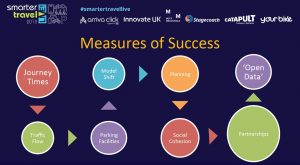Measures of success in selling IoT applications
Many ideas for IoT applications lead to proofs of concept and pilot projects. A few of them progress to commercial operations. This may be for strategic reasons or because they deliver a tangible ROI.
Still, many promising ideas fail to make the grade because they do not meet an investment hurdle. This can be because they are narrow in scope and limited in their measures of success.
An early analysis of the IoT opportunity by McKinsey attributed 40% of the IoT opportunity to interoperability benefits. This means a narrow approach will miss out on the potential for joined-up systems and other promising application opportunities. Industry’s growing clamor for interoperability suggests that 40% might underestimate the upside potential.
So, is there a good way to persuade business decision-makers and technologists about the benefits of joined-up offerings? The best place to explore this idea is in “places.” These are environments where several operational processes occur and possibly interact. Think manufacturing sites, office buildings, smart cities and even transportation hubs, such as airports, bus and rail terminals and so forth.
A smart city example
Taking smart cities as an example, a clever idea that illustrates joined-up thinking comes from a recent presentation that Trevor Brennan, strategy and program manager at Hertfordshire County Council, delivered at the Smarter Travel Live Conference. His example showed how one smart city initiative created the foundation for complementary applications. Eventually, those applications will cross organizational boundaries, break down silos and deliver the benefits that interoperability promises.
Here’s one way to look at this illustration. It begins with a focus on intelligent transport systems, using journey time data at different points in a road network to improve traffic flow. This use case transitions to the management of parking facilities and leads to a shift in the use of different transport modes by the local population. If you follow the nascent market for intelligent and demand response transportation services, you’ll appreciate why so many people are excited by about the mobility-as-a-service industry.
Returning to the illustration, the application opportunities don’t stop there. Once municipal agencies look at different modes of transport, there is a short hop to the issue of short- and long-term planning. This draws in ideas about social cohesion — for example, responsiveness to social media information feeds, optimization of welfare services, better integration of citizens living in affluent and less wealthy neighborhoods and so forth. By this stage, departmental and private-public boundaries are dissolving through partnership operating models, much of this producing and enabled by open data.
This sequencing of opportunities should make decision-makers think broadly about implementation ideas. They should also think strategically when it comes to evaluating these ideas. That’s because many ideas, taken in isolation, will fail an ROI-like investment hurdle. The valuation picture would be different if downstream possibilities had been captured. On top of that, there is the option value inherent in a horizontal-platform approach — i.e., common infrastructure that supports multiple applications and promotes interoperability.
Lessons learned
This daisy chain of applications shows that IoT and smart city opportunities are broad in scope. What lessons does this example hold for decision-makers? One lesson is to apply a broad perspective when designing and evaluating IoT systems. It’s fine to focus startup investments in a single department or a well-defined technology. However, that only works in the long run as long as efficient scaling and the ability to encompass a wider scope of applications are design prerequisites.
A second lesson is about the operational processes for an initial service need. These should not be too rigid. It’s quite likely that procedures will evolve as soon as boundary conditions change. That will result from departments working together, driven by cost pressures and cross-departmental innovation.
Some organizations will spin out individual departments as standalone entities while continuing to work with them. Other factors driving process change will be higher-value and integrated supply chain opportunities. This will occur within and across public-private sector boundaries.
Getting the measures right will ensure that many more IoT applications stand a chance of being sold.
All IoT Agenda network contributors are responsible for the content and accuracy of their posts. Opinions are of the writers and do not necessarily convey the thoughts of IoT Agenda.

